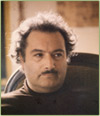              
|
Born in 1930 in Lucerne, André Thomkins suffers from many health problems during the first ten years of his life; in 1934, he undergoes an operation for mastoiditis; in 1940 he suffers from lung disease. At 15, he begins painting and sketching. While taking a high school geometry course, his interest in reproducing geometric figures is awakened. This discovery plays a critical role in his decision to be trained as an artist.
From 1947 to 1949, Thomkins trains at the Kunstgewerbeschule (school of arts) in Lucern under the "Surrealist" Max von Moos. Following a 1948 internship at Unilever in Holland, Thomkins goes to Paris in 1950 to attend the Académie de la Grande Chaumière. Two years later, he marries the artist Eva Schnell and relocates to Rheydt. In this year, he creates the "Schwebsel"-figure. In 1953, the first publication of some of his drawings appears as "Schri Kunst Schri". In 1955, his interest in surrealism grows; at the same time, he discovers, by coincidence, the lackskin technique. Thomkins' acquaintance with, among others, Paul Gredinger, Peter Storrer and Daniel Spoerri begins. With regard to machine photography, he mentions for the first time the so-called "Permanentszene" ("Permanent Scene"). In 1957, he creates the stage scenery for the opera "Die Gans von Kairo". It is also in this year that he writes his first texts with palindromes; in 1959, he compiles several palindromes for the magazine "Nota". At the end of the decade, he also occupies himself with the creation of larger lackskins, which he creates in the bathtub. At the beginning of the new decade, Thomkins writes a long, theoretical text about the history of the lack-technique and its importance for his creations. At the Institute of Contemporary Art in London, his "Lackdynamorphosen" are shown by Spoerri. At the end of 1960, Thomkins exhibits with Schulze-Fielitz in the Galerie Van de Loo. In 1961, he creates the stage scenery for Harold Pinter's play "Der Hausmeister" in the theater at the Dome Cathedral in Cologne. Additionally, he creates the public outdoor area for the cultural center in Leverkusen, designed by Ulrich S. von Altenstadt. Together with Schulze-Fielizt, Thomkins plans the outfitting of a church in Düsseldorf-Eller. In 1962, André Thomkins does a lackskin demonstration; with lackskin, in this year he also develops the Astronaut-Series. He finishes the oil painting "Die Mühlen" and creates the stage scenery for "Ein Amerikanischer Traum" in the theater at the Dome Cathedral. Highlights of the year 1963 include the completion of the large lackskins for the church by Schulze-Fielitz in Düsseldorf-Eller. The first publication about Thomkins, "André Thomkins. OH CET ECHO! PALINDROME SCHARNIERE" appears in this year. In 1964, he created "Shadowbuttoneggs", and in the following year he works on miniature clay sculptures. In 1966, Thomkins takes part in the Protestant convention "Kunst und Kirche" (art and church) and engages in creating glass windows for the Protestant Church of Sursee. Thomkins composes several texts for the publication from Emmet Williams "Anthology of Concrete Poetry" and works on two large glass windows for a special-needs school (which is today called the "André Thomkins School") in 1967. In the following year, his work is exhibited along with that of Karl Gerstner, Dieter Roth and Daniel Spoerri. The year 1969 distinguishes itself as that in which his first major solo exhibition in the Felix Handschin Gallery takes place. Additionally, his creation "Die Sägler und Nagler" is exhibited in front of the Düsseldorf Art Hall. At the begining of 1940, Thomkins works on the first paraphrases of the works of Jacques Callot, Johann Heinrich Füssli, Arnold Böcklin and others for the planned 1971 solo exhibition at the art museum in Basel. In addition, he produces, among other things, dense collages out of cardboard. In 1971, he creates the first prints with his own etching-press; at the art museum in Basel, the first important solo exhibit takes place. Otto Seeber conducts an interview with Thomkins, that is later transcribed. He begins a two-year stint as a teacher of painting and graphics at the Art Academy in Düsseldorf. In the following year, he creates the stage scenery for the play "Das Gasherz" by Tristan Tzara at the playhouse in Düsseldorf. In the period between 1972-76, Thomkins travels extensively, and also suffers two heart attacks. In 1976, he begins to paint with red soil that he brought back from Provence. He is inspired by his wife's colour-scheme of their estate on the Aach; this is reflected in his pantographs. In 1977, an important anthology of Thomkins' print graphics is published under the title "Die Druckgrafik und Monotypisches" (Edition Stähle, Zürich). Another publication to come out in this year is "Permanentszene", with Hansjörg Mayer. Thomkins suffers another heart attack. In 1978, Thomkins relocates to Zurich; in this year, he is also voted into membership at the Berlin Academy of Arts. The following year, he participates in concerts such as "Performance 79" and "Seldom Heard Music" in Munich and Hamburg, respectively. The 1980s begin with a tape-recorded interview with Ursula Perucci-Petri, and his experiment with noise ("Rauschgeräum") is broadcast on Radio DRS2. He is elected as a committee member of the Gottfried-Keller Foundation. With the help of Christoph Gredinger, he builds a 25-meter long xylophone. In 1981, after a 16-year hiatus from lackskins, he produces several in soup-plate sizes. The following year, he receives a DAAD-scholarship in Berlin; additionally, he accepts a teaching position at the Summer Academy in Salzburg. In 1983, he works on a mural in the National Bank in Lucern. Later in the year, Thomkins relocates to Munich. There, he suffers another heart attack. During a visit at Christoph Gredinger's in 1984, Thomkins begins to paint with oils again: In 1985, he takes part in the member-gathering of the Academy of Arts in Berlin and works intensively with oil colours with either "Rapportmuster" or with labyrinth-motifs. On November 9, Thomkins dies of heart failure. |